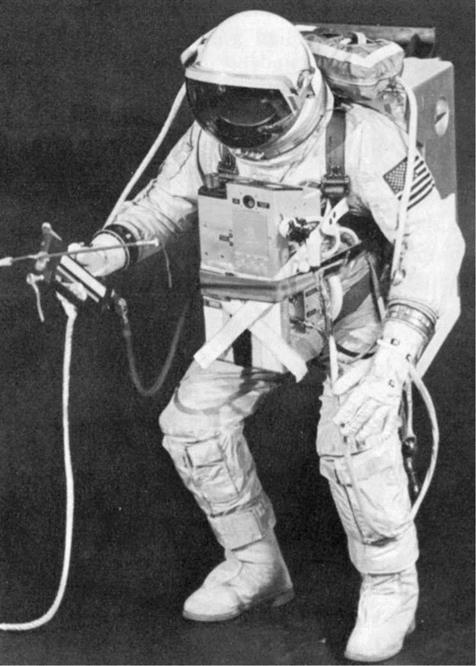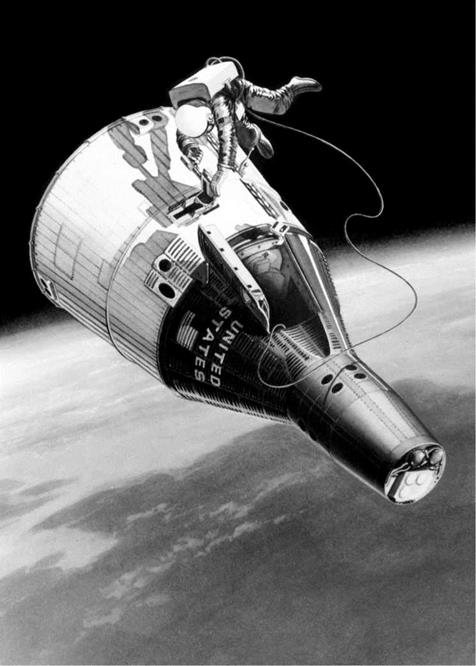TRAINING
Of course, wrote Scott, he had to be sure that Armstrong, as Gemini VIII’s command pilot, was happy with his selection. He need not have worried. “When I caught up with him in a corridor outside the VIP room,’’ Scott related, “he gave me a big grin and held out his hand. That was all I needed.’’
The official announcement came on 20 September, with Pete Conrad and Dick Gordon assigned as their backups. Gemini VIII would be the most complex mission ever attempted, involving all of the tasks practiced by previous flights… and more: three days in orbit, rendezvous – and, for the first time, physical docking – with an Agena-D target, combined manoeuvres, scientific experiments, a precision re-entry and a tricky spacewalk. The sheer complexity of the flight, wrote Scott, “was reflected in our mission badge. . . a rainbow of colours refracted from twin white stars through a prism to form the Gemini symbol together with a Roman ‘VIII’ … to reflect its many objectives’’.
Scott’s EVA was part of a goal that simply had to be perfected before the early Apollo missions and the Department of Defense, through the Air Force, had already invested heavily in an Astronaut Manoeuvring Unit (AMU) to be tested by Charlie Bassett on Gemini IX. Before that, Dave Scott would wear a suit with a chest pack (known as the Extravehicular Life Support System) to feed oxygen from the spacecraft’s supply and from a backpack (dubbed the Extravehicular Support Package) located on the spacecraft’s rear adaptor section. This backpack also provided a radio and 8 kg of propellant for a zip-gun manoeuvring tool – similar to the hand-held device used by Ed White – and was connected to Gemini VIII’s systems by an 8 m oxygen-hose tether.
When Scott reached the rear of the spacecraft and backed himself into the backpack, he would add a lightweight 23 m tether to the hose, allowing him to move up to 30 m into space. The exercise was extremely risky and if Scott encountered problems, there would be no way for Armstrong to aid him: the command pilot therefore requested a realistic model of the Gemini VIII adaptor for training, to rehearse donning the backpack, together with practice runs in an altitude chamber. Scott, meanwhile, worked closely with Ed White and by the eve of launch had completed more than 300 zero-gravity aircraft parabolas and over 20 hours on an air-bearing table, donning and doffing the bulky suit again and again. It was hot, hard, strenuous work. ‘‘I remember Dick [Gordon] turning to me once,’’ wrote Scott, ‘‘drenched in sweat and joking ‘Isn’t this glamorous?’’’
Conversations with White had certainly identified the need for Scott to maintain
|
The space suit and equipment scheduled to be used by Dave Scott on Gemini VIII. |
his physical fitness and strength, particularly in light of the difficulties in closing the hatch on Gemini IV. A consequence of this was that a lever was added to Gemini VUI’s hatch, allowing it to be closed with less physical force. Nonetheless, White cautioned, the space suit itself was both stiff and heavy, requiring strength and stamina to move around for two hours. Scott began jogging, playing handball and lifting weights in the gym. . . and, in his autobiography, would recall how this brought him face to face with Neil Armstrong’s sly humour.
Armstrong’s theory on exercise, John Glenn once said, was that a human being had only a finite number of heartbeats and should not waste them frivolously. One day during Gemini VIII training, as Scott pumped iron in the gym, Armstrong turned up, set the exercise bicycle onto its lowest possible tension setting and began pedalling, telling him: “Attaboy, Dave! Way to go!’’
Work on the 6 x 7 m air-bearing table – which pumped highly-compressed air through holes in its floor to remove friction – allowed Scott to literally ‘fly’ across its surface using the zip-gun, which he described as one of the most valuable parts of his EVA training. The gun had 15 times more propellant than White’s device and, instead of oxygen, used freon, a refrigerant with a correspondingly higher density. This multiplied the gun’s impulse, although Scott worried how the gas might behave in space. During one test at low temperatures, for example, the freon caused the gun’s poppet valve to stick open when triggered. Had this occurred in space, the escaping gas might have caused Scott to tumble uncontrollably. New seals were fitted to solve the problem and two new shut-off valves provided additional safety.
The space suit’s other equipment presented its own problems. One key obstacle was the risk that an ejector in the chest pack could freeze and block the flow of oxygen from both Gemini VIII’s supply and from the backpack. In response, engineers incorporated 20-watt heaters near the ejector. Other obstacles included overcoming the jumble of umbilicals, tethers and jumper cables whilst donning the chest pack inside the cramped cabin, although by December 1965 Scott was satisfied that he could do the task satisfactorily. The explosion of Wally Schirra and Tom Stafford’s Agena-D, on the other hand, did not fill Armstrong or Scott with confidence. Mission Control shared their concerns, telling them to ‘‘get out fast’’ if the target showed the slightest hint of a malfunction whilst docked.
Despite the EVA experience gained by Ed White, the Gemini VIII excursion would eclipse it in complexity. Not only would Scott be outside for two hours and 40 minutes – nearly ten times longer than White – but the flight plan also required him to move to the rear of the spacecraft to don his backpack. He would spacewalk through orbital daytime and nighttime, retrieve an emulsion package, activate a micrometeoroid collector on the Agena and test a reactionless power wrench. As a result, in addition to aircraft parabolas and trial runs on the air-bearing table, he was submerged into a large water tank with a mockup zip-gun to practice moving around in a neutrally-buoyant environment. Today, such underwater exercises are common as spacewalkers rehearse procedures outside the International Space Station and are regarded by many as the closest analogue to the real thing.
Training for the spacewalk was, however, only part of the Gemini VIII mission; Armstrong and Scott’s 70 hours aloft also featured a full plate of experiments. One
|
Artist’s concept of Dave Scott during his EVA. |
of these was the Zodiacal Light Photography investigation, which sought to capture a series of electronically-controlled exposures using a modified 35 mm Widelux camera with a rotating lens. “This was to observe… a very faint glow on the horizon on Earth seen just after sunset and before sunrise,” Scott wrote. To accustom their eyes to the subtle zodiacal light, caused by dust circling towards the inner Solar System, Armstrong and Scott would turn down the lights in their T-38 cockpit during cross-country night flights.
Also aboard Gemini VIII was a hand-held spectrometer to deduce cloud-top heights from the absorption of light by the oxygen band, together with a nuclear emulsion experiment to determine cosmic radiation effects on bromide crystals, a micrometeoroid investigation affixed to the Agena and a series of synoptic terrain photography tasks for meteorological research.












